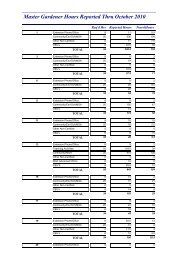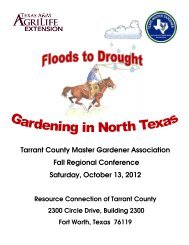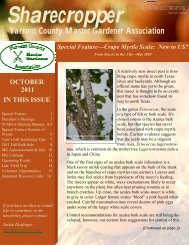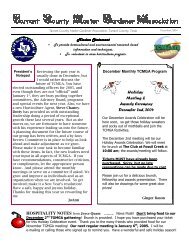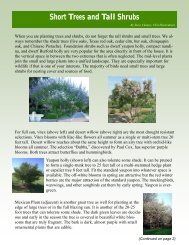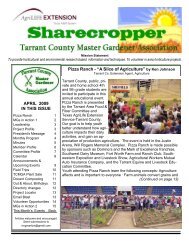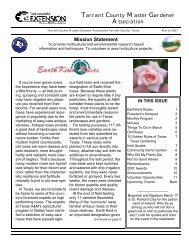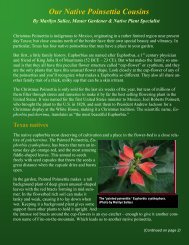december 2010 issue - Tarrant County Master Gardener Association
december 2010 issue - Tarrant County Master Gardener Association
december 2010 issue - Tarrant County Master Gardener Association
Create successful ePaper yourself
Turn your PDF publications into a flip-book with our unique Google optimized e-Paper software.
Sharecropper Page 8<br />
Book Review: “The Botanical Magazine:or, Flower-Garden Diſplayed ”<br />
By Marilyn Sallee<br />
“The Botanical Magazine; or, Flower-Garden<br />
Diſplayed” by William Curtis 1790<br />
Including access to the Biodiversity Library<br />
Online<br />
Everything old is new again. With this book<br />
you’ll find that even the very old, almost as<br />
old as our nation, can be bright shiny new, as<br />
new as the iPad. The book is a botanic catalog<br />
of garden plants by William Curtis from 1790<br />
– that’s the really old part. That it can be read<br />
online, and downloaded as a PDF file and read<br />
on your computer or iPad is the new part.<br />
More on that later.<br />
The book is a meticulously illustrated catalog<br />
of some of the more popular flowering plants<br />
at the Royal Botanic Gardens, Kew Gardens,<br />
London, England in 1790. This is not a fast<br />
read for several reasons.<br />
First, the eye catching illustrations are just too<br />
beautiful; they must be lingered over. They<br />
are hand-tinted and drawn in great detail. You<br />
will recognize many of them – daylily and dianthus,<br />
daffodils and iris, geranium and helle-<br />
bore. From the bold red and white stripes of<br />
the Franklin’s Tartar – “A Scarlet Bizarre<br />
Carnation” or the convolutions in deep orange<br />
of the Eastern Poppy, to the delicate<br />
shading of the Dog’s Tooth Violet (what we<br />
now call the Trout-lily) and pale-pink petal<br />
tips on the Christmas Rose hellebore, each<br />
image is a work of art.<br />
Reading the text takes some doing, since it<br />
was written more than 220 years ago. First<br />
there is the Middle English characters that<br />
convert words to unfamiliar form, such as<br />
“Class” written as “Claſs” and “Character”<br />
becomes “Charaĉter”, but those are easy to<br />
get used to.<br />
Then the names and descriptions are written<br />
in Latin, as was the custom of the time. If<br />
you are familiar with the Linnaean names of<br />
the plants, even the Latin sections are not too<br />
tough going, or skipping over. The index<br />
lists each plant by Latin and common name.<br />
The best parts are<br />
Curtis’ notes and<br />
descriptions of the<br />
plants as they grow<br />
in Kew Gardens.<br />
Curtis takes great<br />
care not only to describe,<br />
but also to<br />
explain growing<br />
conditions, growth<br />
and bloom times,<br />
and even care, such<br />
as suggesting one<br />
keep some purple<br />
coneflower seedlings<br />
under a board



